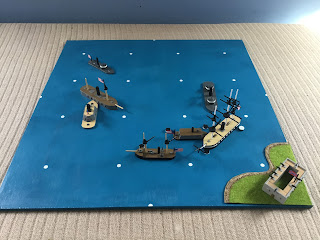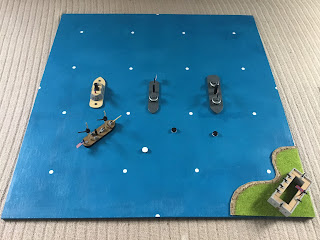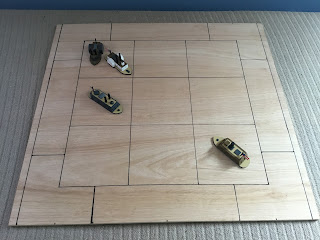First of all I hope you all had a very nice Easter break and that the chocolate was in manageable quantities!
Battle is joined….
With the small ‘90 Day’ gunboat - the U.S.S. Kennebec in the van, the Union squadron manoeuvred into position to begin reducing the rebel fort. So far all was quiet although the telltale signs of funnel smoke were seen rising into the clear August morning sky from beyond the headland due south west.
Initial positions. The Union force was split into two columns with the larger of the two consisting of the U.S.S. Kennebec, the U.S.S. Hartford and the U.S.S. Winnebago. The second column consists of the U.S.S. Galena and the U.S.S. Manhattan. Only the lead ships are currently on the board in the manoeuvring zones. In the bottom right hand of the picture is Fort Yuwatus, proudly sporting the ‘Stars and Bars’. The bottom left of the picture shows the C.S.S. Little Rebel leading the C.S.S. Texas.
Turn 1. No firing as yet and under the scenario conditions the Union moves first this turn so no initiative rolls are required.
End of Turn 1.
The two Union columns continue to move into position when suddenly an explosion is heard close to the U.S.S. Kennebec - she has run into a minefield! (The black spots are mines - ordinarily their position would be recorded on a piece of paper to preserve the element of surprise). The mine successfully explodes but aside from drenching the deck crew has no effect on the Union gunboat - a lucky escape!
Turn 2. Immediately the Confederate fort opens fire on the leading Union ship - the U.S.S. Kennebec. She rolls 2d6 at range 2 requiring 5 or 6 for a hit but as she is a fort gains a plus 1 meaning 4, 5 or 6 will hit. A 5 and a 6 are rolled with the 6 granting an extra roll. As 2 hits have been scored the chance of an extra hit is calculated as 1 or 2 on a d6 - a 2 is rolled meaning that the Union ship has suffered three potential hits. The penetration versus armour modifier is +3 over 0. The three damage rolls are a pair of 2s and a 5, each of which add a +3 making 5, 5 and 8. That is 4 points of damage (1 for each 5 and 2 for the 8 with chance of an additional damage roll - 1 or 2 required but rolled a 4 so nothing doing. Even so, the U.S.S. Kennebec has taken 4 points of damage and is still in the minefield! Initiative was 2 for the Union and 3 for the Confederates - the latter opted to allow the Yankees to move first.
End of Turn 2.
The U.S.S. Kennebec, despite the battering she had received from the guns of the fort, not to mention the near miss of the mine, steamed gamely on to close with the fort - straight into a continuation of the same minefield! Again the mine detonated but to no effect. The plucky ship was certainly riding her luck! Meanwhile the flagship, the U.S.S. Hartford, ignoring the threat from the rebel mines followed in the wake of the U.S.S. Kennebec. Again a large explosion was heard and again the result was the same - a lot of water splashing around but little else - there seemed to be something amiss with the Confederate mines.
Meanwhile the C.S.S. Little Rebel swung her helm hard over and looked to engage the leading Union ship, the so far fortunate U.S.S. Kennebec. The C.S.S. Texas however, only had eyes for the Union ironclad the U.S.S. Galena and so moved into a ramming position.
Turn 3. The fort once again opened fire at the U.S.S. Kennebec. The roll was a 6 and 1 so one potential hit and the chance of an additional (needed to roll a 1 and scored a 6 so no additional hit). The damage roll was a 2 so plus 3 makes 5 meaning a further point of damage. The Union ship fired back at the fort. 3d6 scoring 1, 3 and 6 and a dismal 5 for the potential additional hit (when needing a 1). Her guns are rated 3/3 and the fort armour is a 3 so straight dice are rolled. The score was a 3 so no effect.
Meanwhile the C.S.S. Texas opens fire against the U.S.S. Galena with 2d6 and misses with both. Initiative is 1 for the Confederates and 2 for the Union. The Union opts to move first.
End of Turn 3.
The U.S.S. Kennebec swings across the face of the fort, firing as she goes but to little apparent effect. Almost immediately yet another mine explodes but again, fortune smiles upon her and she escapes with no damage. Similarly the U.S.S. Hartford, still following the gallant U.S.S. Kennebec, sees another explosion of her port beam causing no damage. So far the Confederate minefields have caused no damage to the Union.
The C.S.S. Little Rebel, seeing her intended target sweep alongside her starboard bow immediately changes target and heads at full speed towards the U.S.S. Hartford. The impact shook both ships and the Union flagship staggered under the blow. 4d6 were rolled to hit with 2 x 4 and a 6 coming up meaning 4 points of damage. The additional roll due to the 6 required 3 (3 hits scored) or less to generate a further damage roll and a 4 turned up. The C.S.S. Little Rebel suffered a single point of damage in return as she pulled away from her target.
The C.S.S. Texas crashed into the beam of the U.S.S. Galena and immediately rolled a pair of 4s, a 5 and 6 meaning 4 points of damage - the additional roll came up as a 5 - too much as 4 or under was needed. She did not get of lightly though as she suffered 2 points of damage in return. As the C.S.S.Texas tried to break free her captain realised that the two ships were locked together!
Turn 4. The U.S.S. Kennebec opened fire at the C.S.S. Little Rebel scoring a 2, a 4 and a 6 meaning two hits. The roll for an additional hit was a 6 when a 2 was required. Her guns are rated as 3/3 and the rebel ships armour is a 1 so damage dice each get a plus 2. A 2 and a 3 come up becoming a 4 and 5 meaning a further 2 points of damage on the rebel ship. The U.S.S. Hartford opens fire on the fort and rolls a miserable pair of 1s, a 2 and 3! The U.S.S. Winnebago enters the fray and her target is none other than the C.S.S. Little Rebel. She rolls a 3, a5 and 6 with no extra hit. For damage her guns are rated 3/3 so each hit gains a plus 2 - she rolls a double 1! Somehow the plucky rebel gunboat survives, at least for now.
The fort opens fire on the U.S.S.Hartford scoring a 6 and a 4 but with no additional hit. Her guns are rated 2/3 against the 0 armour of the Union ship. She rolls a 3 and 6 which convert to a 6 and a 9. That is four points of damage in all! The Union flagship has reached her critical point and must now attempt to disengage. Her critical hit is a 2 - hull damage and so the Union flagship slowly settles by the bow.
The currently locked together C.S.S. Texas and the U.S.S. Galena roll to separate and successfully do so - both sides roll a d6 and any 6 frees the two ships. Initiative is 4 for the Union and 2 for the Confederates. The union opts to move first.
End of Turn 4.
The U.S.S. Kennebec pulls clear of the minefields and finds herself more or less parked on the stern of the C.S.S. Texas! The rebel ironclad had separated from the U.S.S. Galena and so both ships attempted to turn away from one another. Meanwhile the U.S.S. Manhattan appeared from behind the Union ironclad to position herself off the bow of the rebel ship.
Meanwhile the C.S.S. Little Rebel, despite being surrounded by enemy warships and having traversed he own minefield spotted the looking bulk of the U.S.S. Winnebago ahead. Immediately her captain ordered full speed and she braced herself to ram the Union warship. The ram roll was a 6, a 5 and a pair of 4s meaning 5 points of damage. The additional roll was a 1 so another damage roll was permitted - this came up as 3 so no effect. The Union monitor was hard hit but in receiving such a heavy blow the C.S.S. Little Rebel suffered 3 points of damage in return - she was now at her critical point and her critical hit roll was a 2 meaning hull damage. This was sufficient to sink the gallant rebel warship. Fortunately the two ships were not entangled so the U.S.S. Winnebago was able to ease away from the sinking enemy vessel.
The U.S.S. Hartford, stopped in her tracks by the recent ram attack of the C.S.S. Little Rebel was immediately subjected to a withering fire from the fort which proved to be too much for her timbers to bear. Her bows gradually tilted forwards as the inrush of water overcame the efforts of the pumps and so she slowly sank in shallow water right under the guns of the rebel fort.
Turn 5. The C.S.S Texas opened fire against the U.S.S. Galena. She rolled a 6 and 4 meaning two potential hits. the additional hit roll was a 6 against a 2 being required. Her guns are rated as 2/3 and the armour of the U.S.S. Galena is a 1 so overall +2 to each damage roll. A 3 and 5 came up converting into a 5 and a 7 making 3 points of damage. No additional damage was scored. Her critical roll came up as yet another 2 meaning hull damage. The options for hull damage are 2 flotation points or 1 flotation point and 1 off the speed. The Union opted for the latter meaning that the U.S.S. Galena was now afloat, barely, but dead in the water. She could however, still fight to protect herself. She returned fire against the C.S.S. Texas but with abysmal effect - she rolled a 1, a 2 and a 3 (the extra d6 is awarded when firing at a target within the same square - it represents point blank fire). The U.S.S. Kennebec also fires at the rebel ironclad and misses with each d6. Finally the U.S.S. Manhattan opens fire. She is rated as 4/4 and rolls no higher than a 2!
Initiative is Union 2 and Confederate 3. The Confederate opts to move first.
End of Turn 5.
The two Union monitors bear down on the fort but the threat of the C.S.S. Texas is real so the U.S.S. Manhattan keeps a wary eye on the rebel ironclad. The U.S.S. Galena is doing an excellent job acting as a breakwater directly in the path of the rebel ship and so the C.S.S. Texas responds in the only way she knows how - she once again steers into the U.S.S. Galena. She roll 4d6 scoring 3 1s and a 6 (no additional) scoring two points of damage. The U.S.S. Galena slips slowly beneath the waves. The C.S.S Texas suffers a further two points of damage for her efforts but luckily for her is not entangled with the sinking Union ship.
The two Union monitors circle ominously and carefully avoiding the suspected rebel minefields.
Turn 6. The C.S.S. Texas, although faced with a Union monitor opts instead to fire at the U.S.S. Kennebec. She hits with one d6 and scores two points of damage - this is sufficient for her to reach her critical point. Incredibly her critical roll is yet another 2! She takes one point of flotation damage and one off her speed. Her return fire is sufficient to cause a single point of damage against the rebel ironclad.
U.S.S. Manhattan fires next. She manages to score 3 points of damage on the rebel ship which takes her to her critical level. The C.S.S. Texas rolls a 4 which reduces her gun factor by 2 in any single arc but in any event she must now break off the engagement.
Endgame. As the U.S.S. Galena slips below the waves the U.S.S. Manhattan (centre) opens fire on the C.S.S. Texas and scores some telling damage. The rebel ironclad is now in serious trouble having dismounted artillery and a hull riven with shot and shell whilst Union warships lurk menacingly between her and safety. The U.S.S. Kennebec, battered but unbowed, limps away from the action. The garrison of Fort Yuwatus are content to be observers for now but they know that their time will come and probably sooner rather than later.
The crew of the C.S.S. Texas let out a ragged cheer as the U.S.S.Galena slowly sank. Their cheers were short lived though as a single turreted Union monitor opened fire at close range. The damage was immediate and telling and so the C.S.S. Texas attempted to limp away from her tormentor. The U.S.S. Winnebago was still in the fight but had sustained below waterline damage at the hands of the C.S.S. Little Rebel and so was in no position to attempt to enter a known enemy minefield.
The U.S.S. Kennebec was still steaming albeit in a very ragged fashion. Her damage was extensive but considering the storm of shot and shell she had been subjected to, along with the ineffective mine attacks, she could be well pleased (and relieved) with her endeavour.
All thoughts of taking on the undamaged Confederate fort were now abandoned as the remaining Union ships decided to retire to regroup and repair. The first assault on Fort Yuwatus had failed and at a heavy cost.
The garrison of the fort watched the retiring Union ships with a mixture of relief and misgivings. The Yankees would be back, in greater numbers and next time there would be little that the rebel navy could do to stop them.
Aboard the C.S.S. Texas, an hour or so later, the captain weighed up his options. None of these were attractive and so, with no hope of exiting the bay he ordered the ship to be run hard aground and fired. It was a bitter but an inevitable ending.
Mobile Bay was now even closer to being entirely in Union hands.
Thoughts on the Game.
Well! The mines were ineffective, gunfire was very hit or miss (literally!) and the ram seemed to be the wonder weapon! Certainly a gunfire/ram attack combination seemed to be very effective which I have no problem with in the context of the game. I had hoped that the fort would be involved but to be honest the Union deployment may have been less than optimum in this respect - perhaps the monitors should have gone in sooner - but I can put this down to an element of overconfidence on the part of the Union command following the earlier victory at Mobile Bay.
The rules worked well - there are still a few minor niggles to contend with - and I am pretty comfortable with them. I just need to get then properly typed up, proof read and play tested.
I thoroughly enjoyed the game and with seven ships on a 3 x 3 playing area it was snug but not overly so. It has certainly given me the impetus to crack on with the remaining ships as well as making some more scenery.
Fort Yuwatus ready for action
The Fort
Very simple to build and not based on anything in particular - I used four Jenga blocks with two of these 3/4 sized, cocktail sticks and pre cut card pieces - but it looks the part and fits in with the ships models very nicely. As a trial run it worked really well and has certainly made me think about some more bespoke models for the period but that is something to think about for another day.
The action viewed from the fort - C.S.S. Texas at the top of the picture limps off slowly to her lonely fate.














































